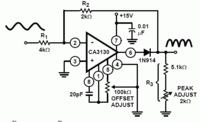yingdea
Newbie level 3

- Joined
- May 1, 2013
- Messages
- 4
- Helped
- 0
- Reputation
- 0
- Reaction score
- 0
- Trophy points
- 1,281
- Location
- New York, NY
- Activity points
- 1,313
Hey All,
I realized a (potential) problem of my ac voltage sensing circuit, attached below.
the current source at the top left outputs ac current, and passes R5 to convert it to voltage and inputted in to the op-amp U1, whose power supply pin connects to GND. The output waveform I wanted is the top half sine or saturated waveform, and let the negative half get chopped out. The question here is that, would the AC voltage across the R5 affect the GND's voltage potential so that the GND of the U1 is actually not zero all the time, and the output wave form cannot be chopped out as wanted?
Thank you guys in advance for your help. My first post ever here. So hope you can help me out of this one!
Best,

I realized a (potential) problem of my ac voltage sensing circuit, attached below.
the current source at the top left outputs ac current, and passes R5 to convert it to voltage and inputted in to the op-amp U1, whose power supply pin connects to GND. The output waveform I wanted is the top half sine or saturated waveform, and let the negative half get chopped out. The question here is that, would the AC voltage across the R5 affect the GND's voltage potential so that the GND of the U1 is actually not zero all the time, and the output wave form cannot be chopped out as wanted?
Thank you guys in advance for your help. My first post ever here. So hope you can help me out of this one!
Best,




